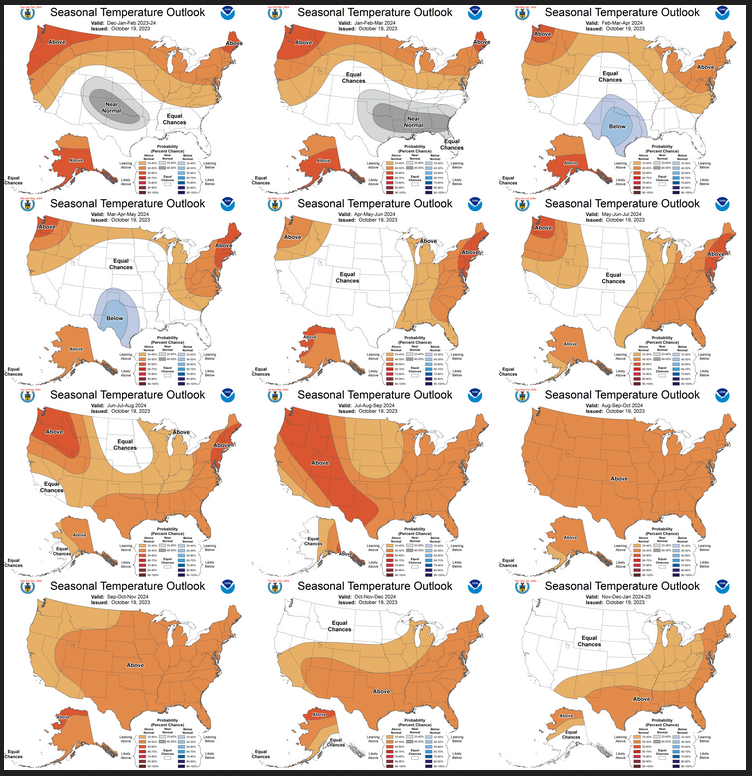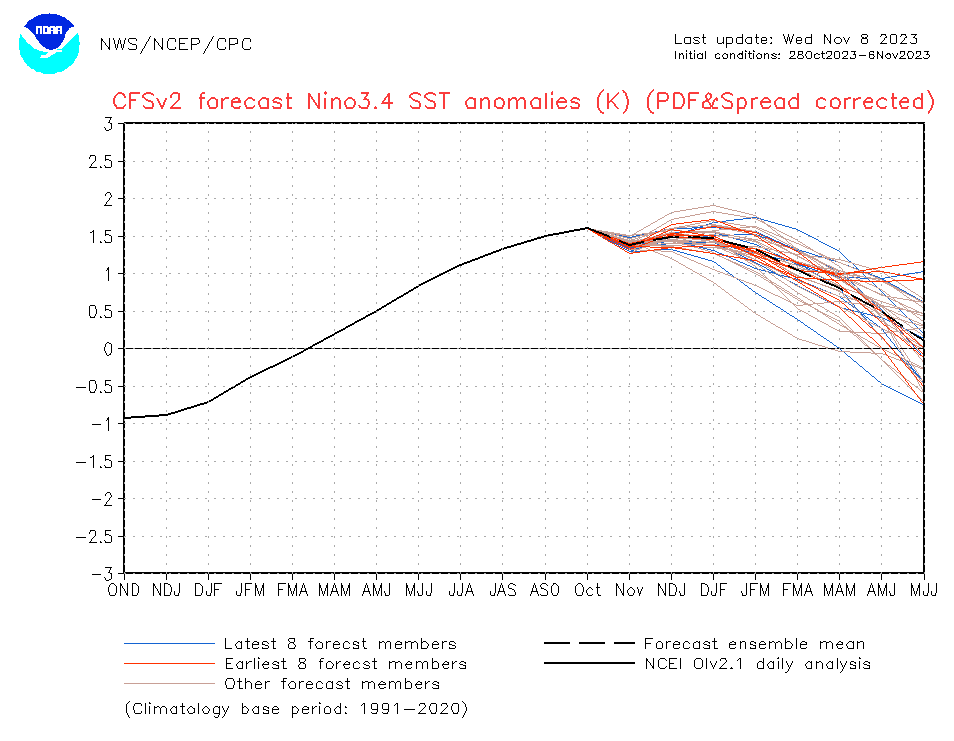On the third Thursday of the month right on schedule NOAA issued their updated Seasonal Outlook which I describe as their Four-Season Outlook because it extends a bit more than one year into the future. The information released also included the Mid-Month Outlook for the following month plus the weather and drought outlook for the next three months. I present the information issued by NOAA and try to add context to it. It is quite a challenge for NOAA to address the subsequent month, the subsequent three-month period as well as the twelve successive three-month periods for a year or a bit more.
First, Let’s Take a Look at the (mid-month) Outlook for December. It will be updated on the last day of November.
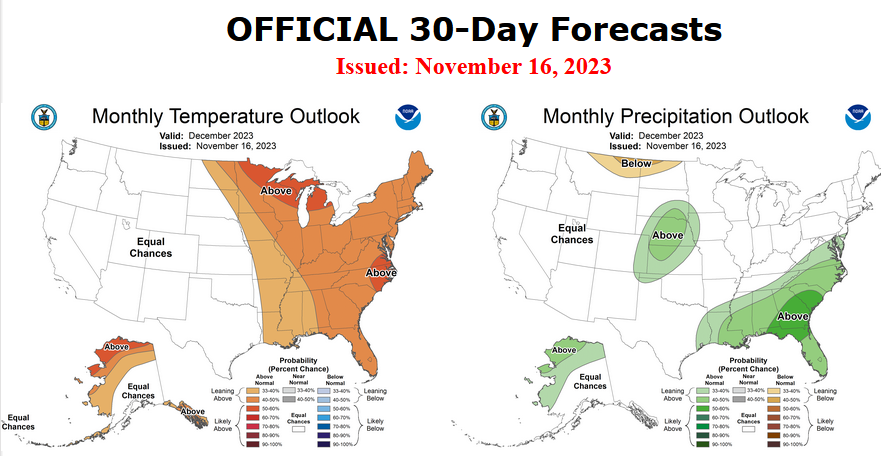
Then I present a graphic that shows both the preliminary Outlook for December and the three-month outlook for DJF 2023-2024. So you get the full picture in one graphic. For some, that may be all they are interested in. Others will be interested in the longer-term predictions and also the rationale supporting the predictions which is mostly provided by the NOAA discussion.
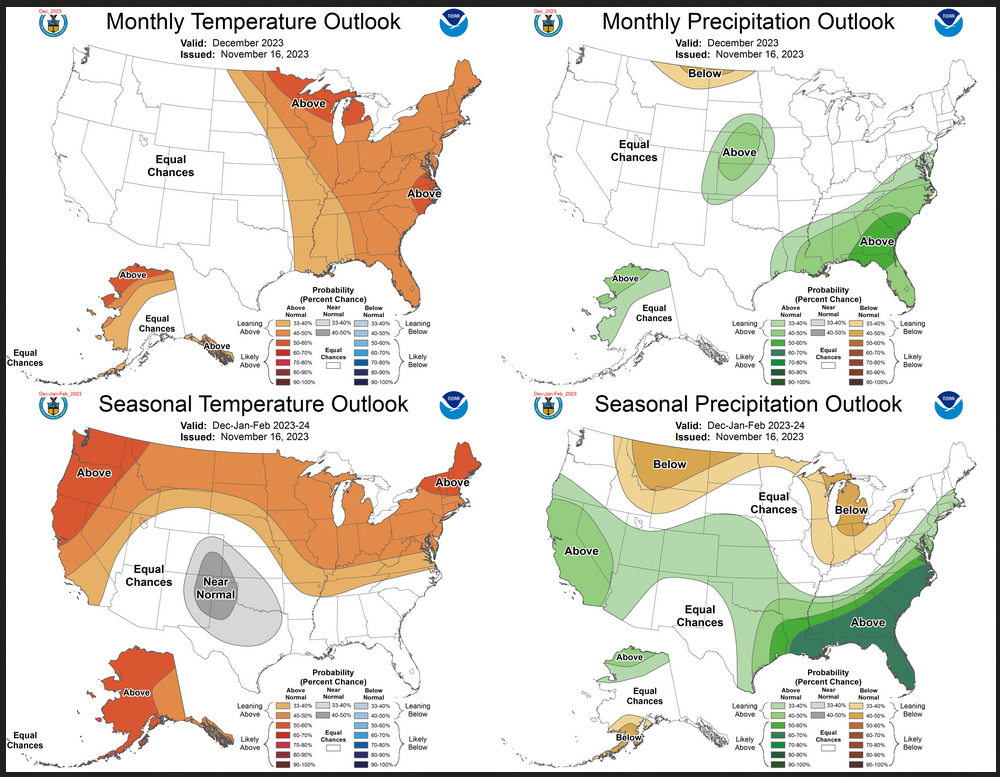
The top row is what is now called the Mid-Month Outlook for next month which will be updated at the end of this month. There is a temperature map and a precipitation map. The second row is a three-month outlook that includes next month. I think the outlook maps are self-explanatory. What is important to remember is that they show deviations from the current definition of normal which is the period 1991 through 2020. So this is not a forecast of the absolute value of temperature or precipitation but the change from what is defined as normal or to use the technical term “climatology”.
| Notice that the outlook for next month and the three-month outlooks are somewhat different with respect to temperature and also to some extent precipitation. This tells us that January and February will be different than December to some extent. |
The full NOAA Seasonal Outlook extends through December/January/February of 2025. All of these maps are in the body of the article. Large maps are there for December and the three-month period Dec/Jan/Feb. Small maps are provided beyond that through February of 2025 with a link to get larger versions of these maps.
NOAA provides an excellent discussion to support the maps.[Author’s Note: many other meteorological agencies see this El Nino being stronger than NOAA does so there is more than usual uncertainty relating to the more distant months.]
Here are larger versions of the Temperature and Precipitation Outlook maps for next month.
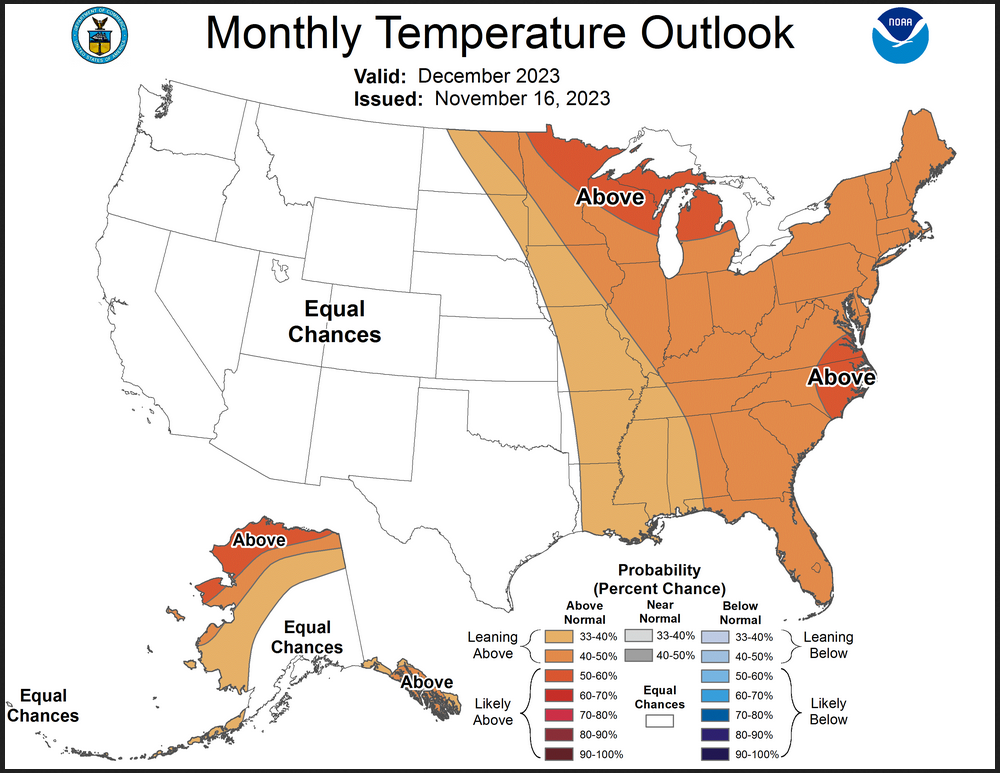

The maps are pretty clear in terms of the outlook.
And here are large versions of the three-month DJF 2023-2024 Outlook
First temperature followed by precipitation.

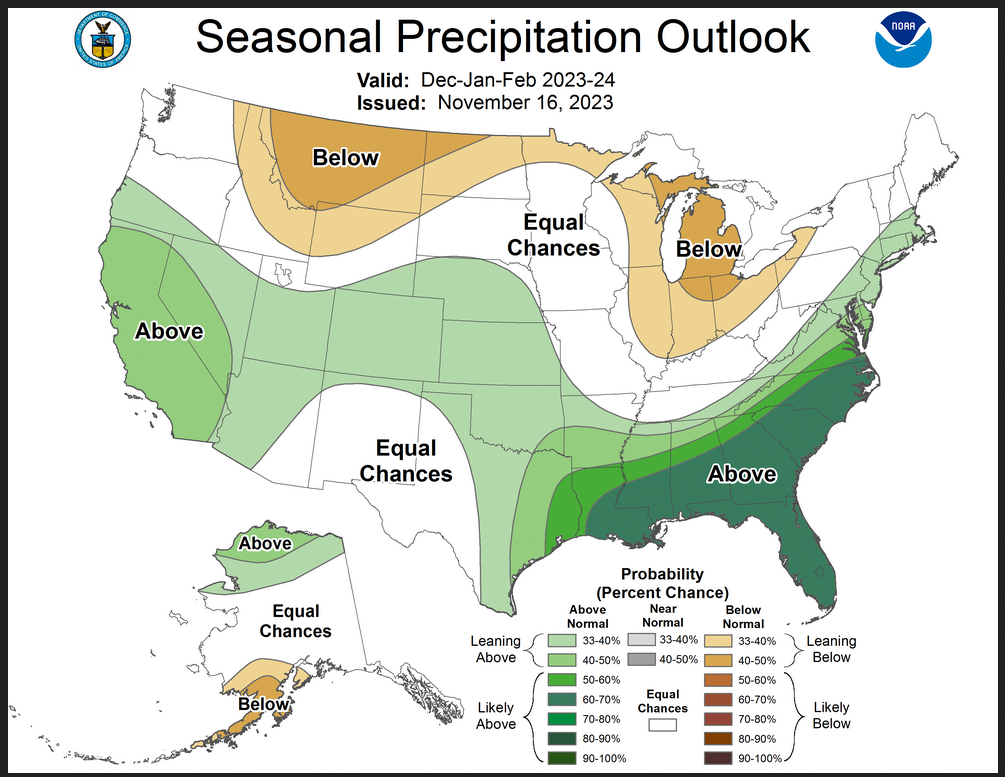
| These maps are larger versions of what was shown earlier. |
Drought Outlook

| The yellow is the bad news and there is none of that. There is a large area where drought removal or lessening is likely to happen plus there is a large area where drought is expected to persist. Overall the level of drought is expected to decline significantly. |
Short CPC Drought Discussion
Latest Seasonal Assessment – During the past month, recharging precipitation overspread much of the upper Midwest and Corn Belt, bringing some amelioration of ongoing drought conditions, though not fully removing drought impacts. Heavy precipitation across Texas also brought some drought relief. In contrast, unusually hot, dry conditions across the Southeast promoted widespread drought expansion and intensification. Drought also slowly expanded across the Four Corners region in areas that received lackluster monsoon rainfall. The seasonal drought outlook for December 2023 through February 2024 is influenced heavily by the anticipated midlatitude response to the ongoing El Nino, which favors an active southern stream with increased moisture across the southern CONUS. Drought reductions are most likely across the Southeast, where severe to exceptional drought has become the most widespread in the nation. Continued drought relief is favored for the eastern half of Texas, but a drier climatology and weaker ENSO climate anomalies favors persistence across western Texas and the Great Lakes region. Seasonal precipitation across the Pacific Northwest favors at least some relief for coastal Washington and Oregon and the Cascades, while climatological dryness and freezing of soils and streams makes persistence the most likely outcome across the northern tier, the north-central Plains, Midwest, and Great Lakes regions. No drought development is anticipated for Alaska during the winter months. Across Hawaii, the disrupted trade wind regime and subsidence to the north of the El Nino enhanced convective response favor a drier than normal start to the wet season. Therefore, drought is favored to persist and expand. The ENSO signal also favors a slightly suppressed signal across the Caribbean, making drought persistence the most likely outcome for Puerto Rico and the US Virgin Islands.
Looking out Four Seasons.
Twelve Temperature Maps. These are overlapping three-month maps (larger versions of these and other maps can be accessed HERE)
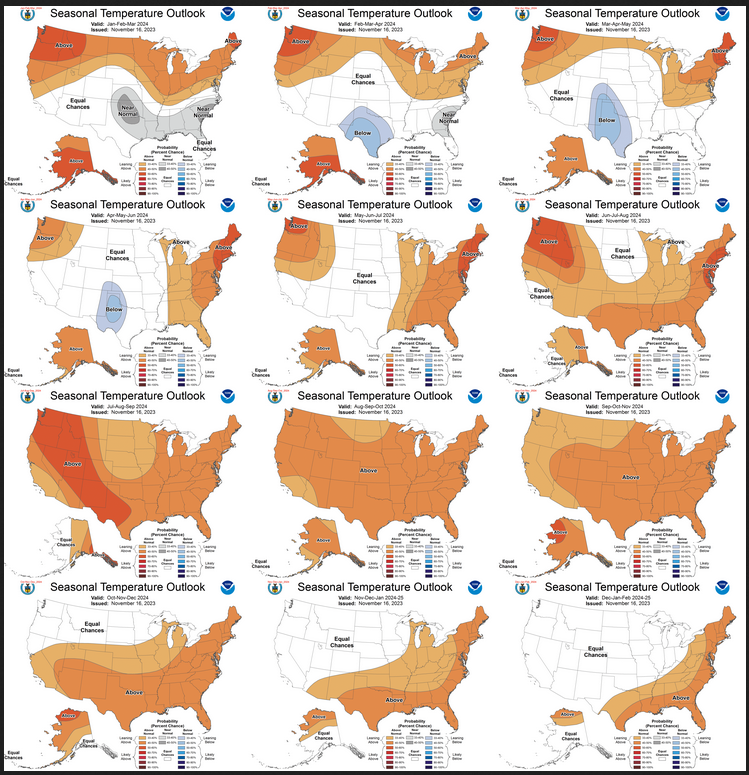
Notice that this presentation starts with January/February/March 2024 (JFM) since DJF is considered the near-term and is covered earlier in the presentation. The changes over time are generally discussed in the discussion but you can see the changes easier in the maps.
Comparing the new outlook with the prior Outlook,
The 12 temperature maps issued last month.
The easiest way to do the comparison is to print out both maps. If you have a color printer that is great but not needed. What I do is number the images from last month 1 – 12 starting with “1” and going left to right and then dropping down one row. Then for the new set of images, I number them 2 – 13. That is because one image from last month in the upper left is now discarded and a new image on the lower right is added. Once you get used to it, it is not difficult. In theory, the changes are discussed in the NOAA discussion but I usually find more changes. It is not necessarily important. I try to identify the changes but believe it would make this article overly long to enumerate them. The information is here for anyone who wishes to examine the changes. I comment below on some of the changes from the prior report by NOAA and important changes over time in the pattern.
| There are some changes from last month’s set of maps but nothing really significant. |
Now the Twelve New Precipitation Maps

Similar to Temperature in terms of the organization of the twelve overlapping three-month outlooks.
Comparing the new outlook with the prior Outlook,
The maps that were released last month.
A good approach for doing this comparison is provided with the temperature discussion.
| There were basically no significant changes from last month’s set of maps. |
NOAA Discussion
Maps tell a story but to really understand what is going you need to read the discussion. I combine the 30-day discussion with the long-term discussion and rearrange it a bit and add a few additional titles (where they are not all caps the titles are my additions). Readers may also wish to take a look at the article we published last week on the NOAA ENSO forecast. That can be accessed here.
I will use bold type to highlight some things that are especially important. My comments, if any, are enclosed in brackets [ ].
CURRENT ATMOSPHERIC AND OCEANIC CONDITIONS
El Niño conditions are observed in both the atmosphere and ocean. In the last 4 weeks, equatorial SSTs were above average across most of the Pacific Ocean and near-to-below average in the western Pacific Ocean. Above average SSTs strengthened near the date line and in the east central Pacific during the end of October and beginning of November. SST anomalies over the recent week were 2.2 degrees C in the Niño1+2 region, and 1.8 degrees C in the Niño 3.4 region.
Upper ocean heat anomalies for 180-100 degrees West have been increasing gradually since early October and positive subsurface temperature anomalies dominate much of the equatorial Pacific Ocean, and strengthened in the early parts of November around 170 degrees East to 130 degrees West. The above normal subsurface temperatures support persistence of the El Niño event.
In the past 30 days positive Outgoing Longwave Radiation (OLR) anomalies are evident in the western Pacific near Indonesia, the Philippines, and Australia, while negative OLR anomalies extend from the date line into the eastern Pacific Ocean. Low level wind anomalies were westerly over much of the equatorial Pacific. Both of these are indicative of the El Niño event, and thus tropical Pacific atmospheric anomalies are consistent with El Niño. Recently, per CPC’s Global Tropical Hazards (GTH) Outlook, a strong Westerly Wind Burst (WWB) is observed in the low-level wind field northeast of Papua New Guinea, which may strengthen El Niño conditions, warming SSTs and enhancing convection east of the date line.
The Madden Julian Oscillation (MJO) appears active as the Realtime Multivariate MJO (RMM) index recently increased in amplitude, however, given the strength and persistence of the El Niño event, El Niño remains the dominant influence on the forecast.
Outside of the Equatorial Pacific, SST anomalies are broadly positive in the North Pacific and Atlantic basins. Positive SST anomalies are also present around the Alaskan coastline, with stronger anomalies along the southern and western coasts, and weaker but still positive anomalies along the northern coast. SST anomalies are also positive along the west coast of the U.S., in the Gulf of Mexico, and up much of the east coast. Negative and neutral to weakly positive SST anomalies are present off the coast of New England.
PROGNOSTIC DISCUSSION OF SST FORECASTS
The CPC Niño3.4 SST consolidation forecast shows a slight increase in the Niño3.4 index to 1.5 to 2 degrees C for November-December-January (NDJ), and a slight decrease to about 1.5 degrees C for DJF 2023-2024. Following DJF, a gradual decrease in SSTs is forecast until around April-May-June (AMJ) 2024, when the forecast reaches near ENSO neutral values. Forecast spread of the consolidation members from present to the AMJ 2024 season is low. Forecast plumes of the Niño3.4 index from the North American Multi-Model Ensemble (NMME) are similar, though the GFDL-SPEAR model forecasts more strengthening of the El Niño event though at least January 2024. Though the tools show a slight decrease in DJF 2023-2024, the aforementioned WWB [Editor’s Note:Westerly Wind Burst] may bring at least short term strengthening of El Niño.
30-DAY OUTLOOK DISCUSSION FOR DECEMBER 2023
El Niño conditions are currently observed, and equatorial sea surface temperatures (SSTs) are above average across the central and eastern equatorial Pacific Ocean. The tropical Pacific atmosphere is consistent with El Niño, and as such we expect El Niño to be the dominant tropical-based teleconnection for December. The Madden Julian Oscillation (MJO) recently weakened according to the Real-time Multivariate (RMM) Index and CPC’s 200-hPa velocity potential index, but is forecast to strengthen later in November. A strengthening MJO could result in more variability over the Western CONUS during through mid-December. In addition to these influencing factors, the December Temperature and Precipitation Outlooks consider local SST anomalies, dynamical model guidance from the North American Multi-Model Ensemble (NMME), Copernicus model suite (C3S), and the Climate Forecast System version 2 (CFSv2), as well as statistical models that include the influence of trend and ENSO. Week 3-4 outputs from CFSv2, ECMWF, and GEFSv12 from mid-November for the early part of December were also considered.
Temperature
The December 2023 Temperature Outlook favors a broad area of above normal temperatures for the eastern CONUS, from the Northern Great Plains to the Lower Mississippi Valley and eastward to the coast. The highest probabilities for above-normal temperatures are over the Upper Mississippi Valley and Great Lakes, where the impacts of trend and ENSO are maximized. NMME outputs support the area of above-normal temperatures east of the Mississippi River, but with lower probabilities than the statistical tools (CCA, CA, OCN). Across the Great Plains to the Rockies, trends are weak and the dynamical model signals are mixed, so Equal Chances (EC) is indicated. OCN indicates warmth across the Southwest while ENSO-OCN favors below-normal temperatures in the Four Corners region. Lagged composites of predicted MJO activity would favor a highly variable pattern across the Rockies, further contributing to the EC outlook there. Across northern California and the Pacific Northwest, the statistical tools and dynamical models both indicate above-normal temperatures, but the spatial patterns in the tools are not aligned, indicating uncertainty in the output and likely uncertainty in the forcing, so EC is indicated there. Across Alaska, recent SST observations are showing above-normal SSTs and lower sea ice coverage, both of which would favor above-normal temperatures for western and Northern Alaska. NMME and Week3/4 model guidance also support broad scale above-normal temperatures across most of Alaska, though tempered by mean troughing associated with the predicted phases of MJO early in the month.
Precipitation
The strongest signal for above-normal precipitation is across the Southeast, consistent with NMME and statistical tool guidance, as well as Week-3/4 guidance. A storm track across the Southeast is consistent with the winter time response to El Niño. The ENSO-OCN tool indicated a wet start to the month from Texas to South Dakota, and the OCN indicates a strong wet trend in the Northern Plains. MJO composites indicate variability in storm track during the month, with early month troughing across the Western CONUS that evolves into an enhanced jet by mid month. That transition and progressive pattern results in EC over most of the Western CONUS, though north of the mean trough likely early in the month is an area across the Northern Great Plains where below-normal precipitation is likely for the month as a whole. Mean troughing to the west of Alaska from MJO composites, trends , and SST patterns indicate above-normal precipitation for western and northern mainland Alaska is the most likely outcome.
SUMMARY OF THE OUTLOOK FOR NON-TECHNICAL USERS (Focus is December through February)
El Niño conditions are currently observed, and equatorial sea surface temperatures (SSTs) are above average across the central and eastern Pacific Ocean. The El Niño Advisory remains in effect, and tropical Pacific atmospheric anomalies are consistent with El Niño. El Niño conditions are forecast to persist into December-January-February (DJF) 2023-2024, and El Niño is favored through Northern Hemisphere spring 2024 with chances gradually decreasing from the winter through the spring. A transition to ENSO-neutral is favored in May-July 2024.
Temperature
The DJF 2023-2024 Temperature Outlook favors above normal temperatures for Alaska, the west coast of the Contiguous United States (CONUS), the Northern Plains, the Ohio and Tennessee Valley regions, and the Mid-Atlantic. Above normal temperatures are more likely for western Alaska, parts of the west coast, and New England. Near normal temperatures are favored for the Central and Southern Rockies, and parts of the Central and Southern Plains.
Precipitation
The DJF 2023-2024 Precipitation Outlook depicts below normal precipitation over southwestern Alaska and above normal precipitation over northern Alaska. Below normal precipitation is favored from the Northern Rockies to the Great Lakes and into the Ohio Valley. Above normal precipitation is favored over parts of the west coast, with a slight tilt toward above normal over parts of the central CONUS. The highest confidence for above normal precipitation is over the Southeast CONUS where teleconnections from El Niño are strongest.
For both temperature and precipitation, areas depicted in white and labeled “EC” (Equal-Chances) are regions where climate signals are weak or inconsistent, and thus equal odds for either above-, near- or below-normal seasonal mean temperatures and seasonal total precipitation amounts are favored.
BASIS AND SUMMARY OF THE CURRENT LONG-LEAD OUTLOOKS
PROGNOSTIC TOOLS USED FOR U.S. TEMPERATURE AND PRECIPITATION OUTLOOKS
Dynamical model forecasts from the Copernicus (C3S) and NMME multi-model ensemble systems are used for the first three and six leads respectively, as well as individual model forecasts from the Climate Forecast System version 2 (CFSv2) and European Centre for Medium Range Weather Forecasts (ECMWF) models as available. The objective, historical skill weighted consolidation that combines both dynamical and statistical forecast tools was also considered throughout all leads. The Calibration, Bridging and Merging (CBaM) tool anchored to the NMME forecasts and “bridged” to the Niño3.4 index is also utilized.
El Niño impacts were considered given the strength and forecasted persistence of the El Niño event through the MAM 2024 season, and El Niño composites and correlation/regression of temperature and precipitation with the Niño3.4 region were used to determine typical El Niño impacts. Statistical guidance such as the global SST based Constructed Analog (CA) and long term temperature and precipitation trends played a role in many of the outlook seasons, particularly beyond lead 6 when dynamical model guidance is unavailable. Coastal SST and sea ice anomalies are considered at early leads.
PROGNOSTIC DISCUSSION OF OUTLOOKS – DJF 2023 TO DJF 2024
TEMPERATURE
The DJF 2023-2024 Temperature Outlook favors above normal temperatures for Alaska, the west coast of the CONUS, the Northern Plains, the Ohio and Tennessee Valley regions, the Mid-Atlantic, and Northeast. The greatest likelihood for above normal temperatures is forecast over western Alaska and parts of the west coast, partially supported by the above normal SST anomalies, and over New England, partially supported by above normal decadal trends . In addition to the SST anomalies and trends , the primary driver for the above normal temperature probabilities in DJF is the persisting El Niño event which is expected to lead to above normal temperatures along the northern parts of the CONUS, and dynamical model guidance that favors higher probabilities for above normal temperatures dipping southward along the west coast and into the Ohio and Tennessee Valley regions. The tilt toward above normal temperatures is maintained over Alaska, the west coast, northern parts of the CONUS, and Northeast until March-April-May (MAM) 2024 when El Niño impacts are expected to begin to wane, and higher uncertainty (EC) is introduced in the Northern Plains. It is notable that support from the CBaM model tilts more toward below normal temperatures in the Northern Plains throughout these seasons, despite the expected El Niño teleconnection. Though the season(s) may tilt above normal in the mean, some periods of cold may occur during winter and early spring.
Near normal temperatures are favored for the Central and Southern Rockies and parts of the Central and Southern Plains in DJF 2023-2024, supported by a consolidation of dynamical and statistical models. Near normal temperatures are also expected for the Lower Mississippi Valley and parts of the Southeast and lower Mid-Atlantic coast in JFM 2024, and over the southeastern coast for FMA 2024. These areas of near normal temperatures represent regions where there is interplay in the tools between expected impacts from El Niño, decadal trends , and dynamical model guidance, leading to a forecast of near normal. El Niño composites tilt weakly toward below normal in the Southeast during winter months, which is balanced by above normal trends and a less confident but still above normal tilt in dynamical model forecasts, which overall supports near normal temperatures.
Beginning in FMA 2024, below normal temperatures are favored over the Southern Plains, which are supported by El Niño teleconnections. This signal is persistent in tools through April-May-June (AMJ) 2024.
From spring (May-June-July, MJJ) into summer and the remaining forecast leads, El Niño impacts are expected to decrease and decadal trends become the primary driver of the forecasts. Predictability decreases in spring and more EC is depicted in the forecasts in the central CONUS. Above normal temperatures are favored over much of the CONUS through summer 2024 and shift toward the east coast by winter 2024-2025. Over Alaska, above normal temperatures are expected through AMJ 2024 given expected impacts from El Niño, and a mixture of EC and above normal temperatures are forecast over the state for the remainder of the forecast leads, mainly driven by trends .
PRECIPITATION
The DJF 2023-2024 Precipitation Outlook depicts below normal precipitation over southwestern Alaska and above normal precipitation over northern Alaska. The southwestern below normal area is consistent with expected El Niño teleconnections, and the northern above normal precipitation is supported by El Niño and decadal trends . Below normal precipitation is favored from the Northern Rockies to the Great Lakes, including parts of the Ohio Valley. Above normal precipitation is favored over parts of the west coast, with a slight tilt toward above normal over the central CONUS. Given a strong connection to El Niño over the Southeast CONUS, the highest confidence for above normal precipitation is over the Gulf States and along the east coast to South Carolina (60 to 70 percent), with probabilities decreasing toward New England. Confident above normal precipitation, with probabilities of at least 50 to 60 percent, remains along parts of the Gulf coast through MAM 2024. El Niño impacts dominate forecast evolution through MAM 2024 for the precipitation outlook, and are modified based on other tools such as NMME, C3S, and decadal trends, as well as a consolidation of statistical and dynamical models .
El Niño impacts are less pronounced in the forecasts beginning in AMJ 2024, and dynamical model guidance (where available) and decadal trends become the primary considerations. A tilt toward above normal precipitation is depicted over parts of the southeastern CONUS and shifting northward to Ohio Valley to the Northeast in AMJ through JJA 2024, and re-emerges for parts of the eastern CONUS in winter 2024 as decadal trends tilt toward above normal precipitation. Based mainly on decadal trends , below normal precipitation is favored over parts of the Northwest and Northern Plains, as well as in the Southern Plains from spring 2024 through early fall 2024. This area of favored below normal precipitation shifts toward the Central and Southern Plains in winter 2024.
For Alaska, a tilt toward above normal precipitation is maintained over northern parts of the state through MAM2024 owing to both El Niño impacts and above normal precipitation trends . Below normal precipitation is favored for the southwest coast in winter 2024, mainly driven by expected El Niño impacts, before above normal precipitation begins to dominate the forecasts by spring 2024 supported by NMME and C3S. From AMJ 2024 onward, long term precipitation trends dominate the forecast over Alaska.
Review of the ENSO Assumptions utilized by NOAA (CPC) in Preparing this Four-Season OutlookThe key information used by NOAA follows.
| It looks like El Nino through the forecast period. It does start to reduce the intensity in FMA2024. There is increasing confidence that this El Nino will weaken in the Spring into the summer which is shown here as the probabilities of El Nino begin to converge with the probabilities of ENSO Neutral which exceeds the probability of El Nino starting with MJJ. |
Tropical Subsurface Temperature Anomalies

| You can update this graphic by clicking HERE and scrolling down to “Mean and anomalous equatorial temperatures“. One has to differentiate between the surface and at depth. |
| The image will update if you click HERE. This model is predicting a fairly strong El Nino (but not a MegaNino) lasting a while. |
Resources
–
| I hope you found this article interesting and useful. |
–

